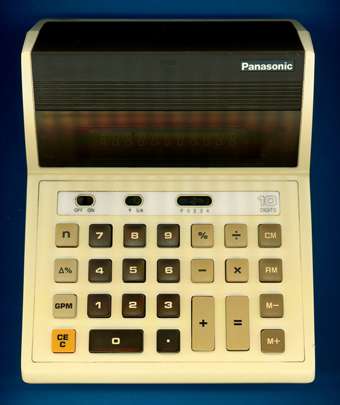
DATAMATH CALCULATOR MUSEUM
 |
DATAMATH CALCULATOR MUSEUM |
Panasonic JE-1604U
| Date of introduction: | 1980 | Display technology: | Fluorescent |
| New price: | Display size: | 10 | |
| Size: | 7.3" x 6.1" x 2.1" 185 x 156 x 54 mm3 |
||
| Weight: | 11.8 ounces, 334 grams | Serial No: | 1Y402007 |
| Batteries: | 2*D | Date of manufacture: | mth 12 year 1981 |
| AC-Adapter: | JL-046, JL-047, or JL-048 | Origin of manufacture: | Japan |
| Precision: | 20 | Integrated circuits: | TMC1081NL (MBSL 8031) |
| Memories: | 1 | Displays: | Futaba 11-BT-16A |
| Program steps: | Courtesy of: | Joerg Woerner | |
| Download manual: |
|

![]()
 Matsushita Electric Industrial Co., Ltd.,
founded by Kōnosuke Matsushita in 1918 as a light bulb socket manufacturer
and better known under their current name
Panasonic Corporation or
National brand, is a major Japanese multinational electronics company, headquartered in Kadoma,
Osakas. Matsushita introduced already in 1969 with the PANAC-12W (JE-240) their
first electronic desktop calculator with 12-digit capability and Nixie tube
display joining established Japanese manufacturers like Busicom, Canon, Sanyo,
Sharp, Sony and Toshiba. Next important step in Matsushita's calculator line was
the sleek Panasonic 1000 (JE-102) introduced in 1971 and based on seven LSI (Large
Scale Integration) chips manufactured by Mitsubishi before introducing in 1972
the Panasonic 1010 (JE-1010) with just two Mitsubishi LSI chips and finally
switching with the JE-801 and JE-1001 to Texas Instruments'
single-chip calculator technology.
Matsushita Electric Industrial Co., Ltd.,
founded by Kōnosuke Matsushita in 1918 as a light bulb socket manufacturer
and better known under their current name
Panasonic Corporation or
National brand, is a major Japanese multinational electronics company, headquartered in Kadoma,
Osakas. Matsushita introduced already in 1969 with the PANAC-12W (JE-240) their
first electronic desktop calculator with 12-digit capability and Nixie tube
display joining established Japanese manufacturers like Busicom, Canon, Sanyo,
Sharp, Sony and Toshiba. Next important step in Matsushita's calculator line was
the sleek Panasonic 1000 (JE-102) introduced in 1971 and based on seven LSI (Large
Scale Integration) chips manufactured by Mitsubishi before introducing in 1972
the Panasonic 1010 (JE-1010) with just two Mitsubishi LSI chips and finally
switching with the JE-801 and JE-1001 to Texas Instruments'
single-chip calculator technology.
This JE-1604U desktop calculator was introduced in 1980
together with its portable twin JE-170U and provides 20-digit arithmetic and a
10-digit display. When the calculated result exceeds 10-digits before the
decimal point, the overflow symbol "C" or "E" lights up at the left of the display and
the approximate result can be obtained by multiplying the displayed number by
1010.

 Dismantling the featured JE-1604U manufactured in December 1981
by Matsushita in Japan for the North American market reveals a cost optimized design
based on a single-sided printed circuit board (PCB) centered around a
TMC1081NL
single-chip calculator circuit connected to the keyboard and powered by two DD-sized disposable Alkaline batteries.
Dismantling the featured JE-1604U manufactured in December 1981
by Matsushita in Japan for the North American market reveals a cost optimized design
based on a single-sided printed circuit board (PCB) centered around a
TMC1081NL
single-chip calculator circuit connected to the keyboard and powered by two DD-sized disposable Alkaline batteries.

 The TMC1081NL is a member of the
TMS1000 Microcomputer family introduced in October 1974 with the
SR-16 calculator. While the
TMS1000 design was mainly intended for
designs using power-hungry LED displays with external display drivers, uses the
TMS1070 redesigned output drivers for the 11 R-Outputs (Display Scan) and 8
O-Outputs (Segments) that can withstand voltages up to -35 Volts and hence
allows direct operation of low-voltage Vacuum Fluorescent Displays (VFDs).
The TMC1081NL is a member of the
TMS1000 Microcomputer family introduced in October 1974 with the
SR-16 calculator. While the
TMS1000 design was mainly intended for
designs using power-hungry LED displays with external display drivers, uses the
TMS1070 redesigned output drivers for the 11 R-Outputs (Display Scan) and 8
O-Outputs (Segments) that can withstand voltages up to -35 Volts and hence
allows direct operation of low-voltage Vacuum Fluorescent Displays (VFDs).
![]()
 The
JE-1604U makes fully use of the TMS1070 design and we could identify on the
PCB both the voltage converter to generate a -32 Volts supply for the
Futaba 11-BT-16A VFD and the external "pull down" resistors for the R- and
O-Outputs. A very similar design was introduced already with the
TI-2550 II, the first
application of the TMS1070 chip.
The
JE-1604U makes fully use of the TMS1070 design and we could identify on the
PCB both the voltage converter to generate a -32 Volts supply for the
Futaba 11-BT-16A VFD and the external "pull down" resistors for the R- and
O-Outputs. A very similar design was introduced already with the
TI-2550 II, the first
application of the TMS1070 chip.
 If
you compare this JE-1604U with the JE-170U using an identical TMC1081NL chip, you'll notice
a different number of keys and you might ask yourself: Are there even more features and
functions available with the TMC1081 chip that neither of the two calculators is
using? And how do they control a 10-segment display with just 8 O-Outputs? Hint:
Only 9 segments are used with the two calculators. Learn
more about Characterization of Single-Chip Calculator Circuits with the
DCM-50A Platform.
If
you compare this JE-1604U with the JE-170U using an identical TMC1081NL chip, you'll notice
a different number of keys and you might ask yourself: Are there even more features and
functions available with the TMC1081 chip that neither of the two calculators is
using? And how do they control a 10-segment display with just 8 O-Outputs? Hint:
Only 9 segments are used with the two calculators. Learn
more about Characterization of Single-Chip Calculator Circuits with the
DCM-50A Platform.
If you have additions to the above article please email: joerg@datamath.org.
© Joerg Woerner, December 28, 2022. No reprints without written permission.